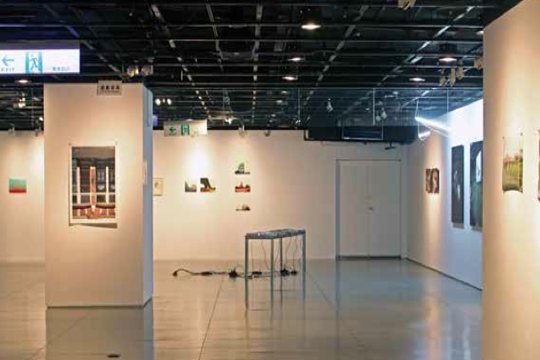URBAN SYNESTHESIA
| June 5, 2013 | Post In LEAP 20

“Let’s get lost, lost in each other’s arms / Let’s get lost, let them send out alarms,” Chet Baker praises the romantic mystique and disruptive force in letting go of orientation. This lust of wandering reflects the mood of “Urban Synesthesia,” a five-person group exhibition curated by Wang Chun-Chi. The usual highways to understanding an artwork— such as work labels, artist names, sale dots, and wall divisions— are all absent, leaving the viewer to orient oneself at a slower speed with no clear guides or suggested trajectories. In this manner, the viewer is encouraged to operate on a situationist dérive à la Debord, to drift through the two adjacent gallery spaces that together host five ongoing art projects concerning the visual textures of urban landscapes. Each presentation consists of multiple pieces, including photographs of various sizes, drawings, video, and sculptures. The end of one presentation and beginning of another is suggested only by relative gaps between them. The result is an organic psycho-geography emancipated from the gallery’s neurosis for indexing inventory. Such a re-envisioning of the white cube’s architectonics was inspired by the artists’ and curator’s shared interest in sensory experiences alternative to the average urban dweller’s utilitarian rationale.
The five artists, Ting Chaong-Wen, Onejoon Che, Liu Ho-Jang, Chihiro Minato, Rumiko Hagiwara, and George Chang, boast an attractive inter-Asian diversity, yet their works relate to each other not by cultural signifiers but rather by camaraderie in the reinvigoration of ways of seeing. The show title “Urban Synesthesia” promises a poetic alchemy of the senses, which is presented in a raw, unsublimated state by Rumiko Hagiwara. Five A1-size photographs hang by binder clips, paired with trigger words scrawled on the wall. The experience of viewing mundane city sights is made serendipitous by the cognitive osmosis between what is visually seen and what is linguistically understood by its associated word. Image and text, like two columns, define a boundless space that is specific to Asian sensibilities, according to Japanese architect Toyo Ito, who describes space as “an emptiness… where multiple relationships can be engendered.” Similarly, Onejoon Che explores the possibilities of meandering in the gap between reality and imagination through his three-channel film The Spinning Wheel, in which fact and fantasy indistinguishably interweave in a docufiction of Mullae-dong, an industrial neighborhood in Seoul now permeated by an influx of artist studios.
Both Chihiro Minato and Liu Ho-Jang interject public systems of meaning and trace their evolution over time. Minato’s photographs depict found text in public spaces of radioactive Fukushima. “Break Me Down,” “The Old Taste of Kitakata Forever,” “God Decided The Judgement Day”— this collection of utilitarian graffiti, commercial phrases, and religious warnings evoke meanings beyond their original intentions— placed in an abandoned town of hopeless disintegration, they now call upon existential questions. Meanwhile, Liu’s artistic engagement with Taiwan’s culture of street vendor cuisine constructs chemistry between the visual languages of cuisine and art. The presented artworks, four high-gloss photographs and five dimly-lit light boxes scattered on a custom-made steel table, represent a small part of the project’s larger body of work. This economical selection is too opaque to engage viewers who are unfamiliar with his work, instead leaving them alienated and disengaged.
“Urban Synesthesia” does not present any politically overt artworks, yet the show offers a visual emancipation from institutionalized structures of exhibition language and market consciousness. According to Hagiwara, “It looks like its effect is too weak but people might carry the suggested senses over into their daily lives and it may run on longer afterwards.” The temporality of this experience is accentuated as, at the end of the viewer’s visit, a guard in full uniform (sash and belt and all) guides you to a list with detailed object descriptions, editions, prices, and artist bios. Incidentally, “Urban Synesthesia” and its participating artworks are fully armed for institutional survival.

